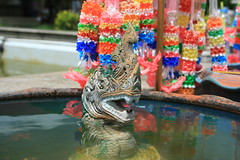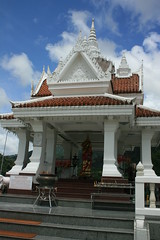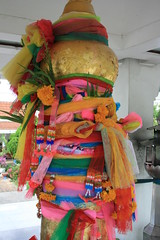One of the best museums in Thailand is the relatively new
Museum Siam (มิวเซียมสยาม), located at the southern end of the Rattanakosin island in the former building of the Ministry of Commerce. I
learned about it from the great website Tour Bangkok Legacies, where a lot of special places within Bangkok off the beaten track are featured. While it has only few original antique items - if you prefer to see that better go to the National Museum in the north of Rattanakosin -the way of presenting the history of Siam/Thailand is much easier accessible than in the older style presentation of the National Museum. And one big advantage of the latter - here photography in the museum is not only allowed, the clerk who sent me to the first room even explicitly notified me that I can take photos of everything. Also many exhibits are free to be touched for completely experiencing the items.
The first room is a big auditorium, where a
short movie is shown as an introduction to the main theme of the museum - why is typically Thai. The movie also introduces the emblem of the movie, a red character in a frog style standing position. One will find many variations of the emblem in the later rooms, but very nice are those hanging in the staircase one has to go up to the third floor. But before the staircase one enters the first exhibit room, which is kind of a wild collage of all the cliches of typically Thai - Muay Thai, temple dancers, a spirit house, a street food carriage and of course inevitably a Tuk Tuk, ready to sit inside to pose.

Starting in the third floor with the early history - starting way before prehistory with the dinosaurs found in the Northeast, racing from the Lampang Man (
Homo erectus) and the
prehistoric remains, reaching the mostly mythological Suvarnabhumi country as the first main stop. Since Suvarnabhumi more refers to the whole South East Asia, on what later became Thai soil it had the first city states of the Dvaravati culture, which later became replaced by the first Thai city states.
With Ayutthaya being the most successful of these city states, the next room features beautiful boats hanging in the center and several dioramas depicting scenes from various times in this city - a royal cremation, a market, even a Christian church built by the western missioners. Another one room focuses on Buddhism, and one on the culture of war in these times.
One floor down the exhibitions continues with the map room, not only showing old maps like the famous
Carte du Royaume de Siam et des Pays Circonvoisins and the first modern cartographic map of McCarty finished in 1897, but even more notable the depiction of the change of the boundaries of Siam is critical of the nationalistic use of these maps and - of course hardly possible in such a short presentation - shows many of the main points of the highly recommended book "
Siam Mapped".
The various cultures in Siam at the beginning of the 20th century are shown in small windows with audio and video, and small items typical of them - I photographed the Chinese as the most iconic of them.
The contrast between the farming communities and the modern technology coming into Siam at that time is shown next, including the first postbox of Siam. Next step is already the nationalist Phibun regime, again (at least in English) the description of the displayed items is notable critical of the ideas of these times, where anyone who disagreed with the government policies was termed non-Thai.
A 1960s TV station where one can try to sit as a news announcer in front of the camera is next, and a bar of the about the same time. A time tunnel into the future is then the exit of the exhibition.
The only point I could criticize about the museum is the pricing - like many venues it does the infamous double pricing, whereas foreigners pay 300 Baht, while Thai only pay 100 Baht. It is worth the inflated price nevertheless, but would probably attract even more foreigner with a more fair pricing - and an English website would definitely help to spread to word better, inside the museum everything is bilingual already. Whereas many museums in the western countries have their exit directly into the museum shop, I completely failed to find the museum shop here and wondered why there's no merchandise with that nice emblem. Only after I checked the website again later I noticed that there is a museum shop, but it must be quite well hidden.
Also notable is the fact that this museum is the first one in Thailand which is present in the Web 2.0 - they're quite active on
Facebook as well as
Twitter; and there are two branch museums planned already, one in Lampang and one in Chanthaburi. When I come in either of these cities these museums will definitely be on my itinerary.
 While I was looking to find the district office of Samphanthawong, I at first misread the map and only looked directly at the rim of the Chao Phraya river. Though I could not find the office there, I instead found a beautiful historic building, which one most easily can see when traveling on the river with the express boat. From the street it is a bit hidden, while the gate marking it a Siam Commercial Bank office is easy to notice, the building inside the compound is hardly been seen.
While I was looking to find the district office of Samphanthawong, I at first misread the map and only looked directly at the rim of the Chao Phraya river. Though I could not find the office there, I instead found a beautiful historic building, which one most easily can see when traveling on the river with the express boat. From the street it is a bit hidden, while the gate marking it a Siam Commercial Bank office is easy to notice, the building inside the compound is hardly been seen. From the website Tour Bangkok Legacies I later learned that this building was built 1906–1910, and was designed by the famous Italian architect Annibale Rigotti (1870-1968). The same architect who also designed the Hua Lamphong railway station as well as the Ananda Samakhom Throne Hall. When finished, the building became the headquarter and first branch of the Siam Commercial Bank (ธนาคารไทยพาณิชย์), which was established in 1906. Until 1971 the headquarters remained in this location.
From the website Tour Bangkok Legacies I later learned that this building was built 1906–1910, and was designed by the famous Italian architect Annibale Rigotti (1870-1968). The same architect who also designed the Hua Lamphong railway station as well as the Ananda Samakhom Throne Hall. When finished, the building became the headquarter and first branch of the Siam Commercial Bank (ธนาคารไทยพาณิชย์), which was established in 1906. Until 1971 the headquarters remained in this location. Later in 1983, the building housed the Thai Bank Museum, which however was moved into the new headquarter building of SCB in 1996 as well. Yet I think this building would be a much better location for such a museum, both easier located for tourists than the bank headquarter in the northern outskirts but also more fitting into this historic building than a normal bank branch office.
Later in 1983, the building housed the Thai Bank Museum, which however was moved into the new headquarter building of SCB in 1996 as well. Yet I think this building would be a much better location for such a museum, both easier located for tourists than the bank headquarter in the northern outskirts but also more fitting into this historic building than a normal bank branch office.













